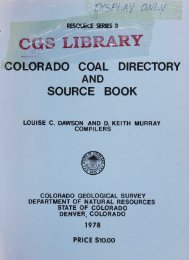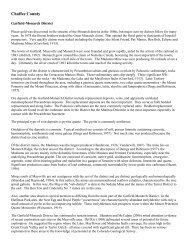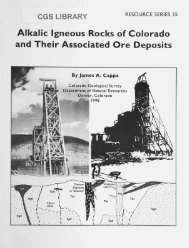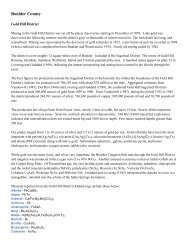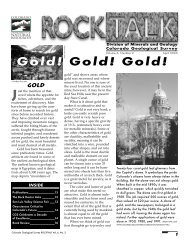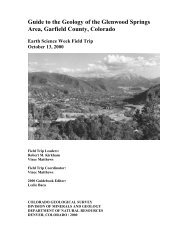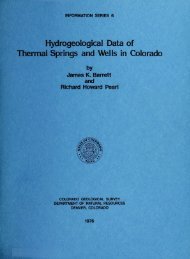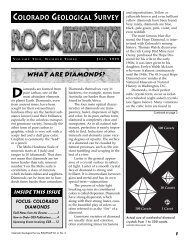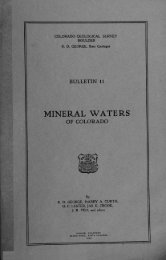Marble - Colorado Geological Survey
Marble - Colorado Geological Survey
Marble - Colorado Geological Survey
You also want an ePaper? Increase the reach of your titles
YUMPU automatically turns print PDFs into web optimized ePapers that Google loves.
closing of the Midnight Mine near Richmond<br />
Hill in 1952.<br />
A number of ore deposits are associated with<br />
the Middle Tertiary plutons of the Elk Mountains.<br />
Deposits of contact metasomatic iron,<br />
disseminated sulfide, and fissure-vein leadzinc-silver<br />
occur in and adjacent to granodiorite<br />
intrusives. Except for iron produced by Pitkin<br />
Iron Corporation during the 1960s, and possibly<br />
some sporadic precious and base metal production<br />
from fissure-veins, no significant metal<br />
production can be attributed to the Middle<br />
Tertiary deposits.<br />
At the head of Cooper Creek in the southeast<br />
corner of the Hayden Peak quadrangle, a<br />
contact metasomatic deposit of iron has been<br />
mined by open pit methods. The iron deposit<br />
occurs in highly recrystallized limestones of the<br />
Belden Formation adjacent to Tertiary intrusive<br />
rocks. The ore was emplaced in steeply<br />
dipping fractures which are most likely associated<br />
with intrusion of the White Rock pluton.<br />
The ore consists of massive magnetite with<br />
some pyrite.<br />
As previously mentioned, disseminated<br />
sulfides are a common occurrence in granodiorites<br />
of the White Rock pluton, as well as in adjacent<br />
hornfels and to a lesser extent, marbles.<br />
The deposits are mostly pyrite, but local occurrences<br />
of disseminated molybdenum and copper<br />
have been reported. There are no records of<br />
metal production from altered granodiorite or<br />
other pyritized units. CGS observed an old<br />
prospect adit and dump which was developed<br />
on an outcrop of pyritized hornfels unit at the<br />
southern end of the California placer. Assay<br />
results and panned concentrates from the<br />
dump contained low metal values. These deposits<br />
are not economically important.<br />
Minor, non-extensive quartz-carbonatepyrite<br />
veins cut red-beds, hornfels and other<br />
strata above and adjacent to the White Rock<br />
pluton remote from the subject property. These<br />
fissure-veins locally contain sphalerite, silver<br />
bearing galena, and very rarely gold. Fluid<br />
inclusion data from veins of this type indicate<br />
they are related to post-magmatic alteration<br />
and mineralization associated with the intru<br />
sion of granodiorite, as in disseminated deposits.<br />
Production from these structures has been<br />
minimal. The most noteworthy mine developed<br />
on this type of deposit is the Montezuma mine<br />
just northeast of Castle Peak. Records show a<br />
total production of 6,700 tons of ore. No grades<br />
are available for ore mined or shipped. Fissure<br />
type veins have been reported to occur in the<br />
upper Conundrum valley. The Cummings property,<br />
on the west side of Conundrum gulch, has<br />
been alleged to contain fair values in silver. CGS<br />
did observe and sample a number of pieces of<br />
'Vein float" which were picked up in the stream<br />
bed. No veins were observed on the subject<br />
property. Assay values on "vein float" were low<br />
for both gold and silver (Plate 3, Table 1).<br />
Geochemical analysis of samples taken in<br />
"reconnaissance" fashion by CGS are documented<br />
in (Plate 3, Table 1). Whole rock and<br />
panned stream sediments were tested for multiple<br />
elements. Fire assay and atomic absorption<br />
analyses for gold and silver on select whole<br />
rock samples gave low results. Several high<br />
values for copper, both in pan concentrates and<br />
rock samples are interesting, but are not considered<br />
to be indicative of high mineral potential<br />
within the claim boundary. Assay and<br />
atomic absorption analyses mineralization from<br />
the property were also consistently low.<br />
Although Leadville Limestone represents<br />
favorable host rock in known mining districts.<br />
No Leadville rocks were observed on or immediately<br />
adjacent to the property. This fact, combined<br />
with the complex structure in the area<br />
and the extreme variation in the thickness of<br />
the Belden Formation, make accurate estimation<br />
of depth to this horizon difficult.<br />
Placer gold potential of the claim block was<br />
tested by hand panning methods. This technique<br />
will only test the immediate surface and<br />
cannot lend insight into placer potential of deep<br />
gravels or bedrock surface where most of the<br />
gold would accumulate. The original placer<br />
claims along Conundrum Creek extend for approximately<br />
6,000 feet and from an elevation at<br />
the north of 8,600 feet AMSL to 9,800 feet at<br />
the southern end. The extreme southern end of<br />
the claim block was considered by CGS to have<br />
17



